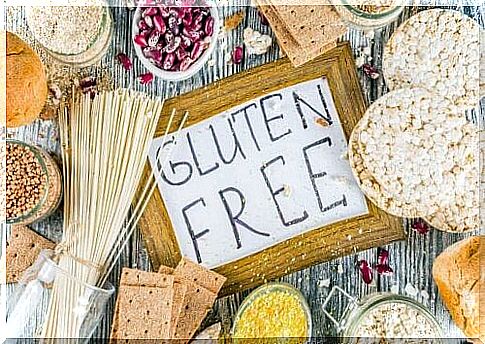Breaking The Myths About Gluten
There are many myths about gluten that have caused millions of people to restrict gluten-rich products without having a related disease. Check Out These Myths And Face The Marketing, Not All That Said Is True!

Today, the only treatment for gluten-related disorders is its absolute restriction in the diet. However, in general, there is a trend in the population that leads to a baseless gluten-free diet. Haven’t you spotted the myths about gluten yet?
There has been so much talk about this protein, found in foods like wheat, that some people point out that its restriction improves health, contributes to weight loss, or that its ingestion is toxic to humans. Therefore, there is a need to shatter these myths about gluten imposed by marketing and society.
What is gluten?
To begin with, it is convenient to do a review of the meaning of gluten. Wheat is one of the whole grains with the highest production and consumption in the world, thanks to its nutritional value and chemical properties.
It is made up of two main proteins: gliadin and glutenin (mainly called gluten). However, there are proteins found in other whole grains such as rye (secalin) and barley (hordein) that have similar chemical and functional functions, as well as interactions in the body.
Impact of gluten on industry and health
Some scientific articles refer to these proteins as key components of the food industry. Indeed, they provide viscosity, elasticity and allow water absorption in bakery products.
They also provide important organoleptic characteristics to products such as pasta, meats, ice cream and salad dressings.
Although gluten has multiple functional properties, there are unwanted effects after consumption in some individuals.
Evaluation of proprietary diets in these proteins has historically and consistently shown that wheat and other related proteins are common factors that induce gastrointestinal symptoms and damage in vulnerable populations.
Being a protein that interacts with genetic and environmental factors, it is necessary to know its interactions in the body, the possible alterations and the associated diseases, in order to dispel the myths of gluten that generate non-medical diagnoses and unnecessary dietary changes.

Gluten-related diseases
Gluten-related health disorders are defined by the adverse reaction, mediated by the immune system or other mechanisms, after its ingestion, as indicated by research published in Critical Reviews in Food Science and Nutrition. Among them, the most common are:
Celiac disease
To begin with, celiac disease is an autoimmune bowel disease that is produced by exposure to gluten and other related proteins in the diet, as well as by the interaction of genetic and environmental factors. The worldwide prevalence of this disorder is only 0.5 to 1%, according to experts.
From determinants of the major histocompatibility complex, the disease is associated with an inflammatory response (mediated by pro-inflammatory cytokines and special T lymphocytes) to the consumption of gluten which generates intestinal damage in a genetically vulnerable population.
By generating damage to the intestinal mucosa, the villi responsible for the absorption of macro and micronutrients are altered, generating serious problems with the nutrition of the individual.
Its diagnosis is complex because many symptoms are attributable to other diseases. Therefore, serological tests are needed to detect specific immunoglobulins and antibodies, as well as a duodenal biopsy. Some of the main symptoms are:
- Gastrointestinal disturbances such as nausea, vomiting and frequent diarrhea.
- Growth arrest.
- Dermatitis herpetiformis.
- Low weight.
- Amenorrhea

Allergy to wheat and other proteins
This is a type E immunoglobulin-mediated response to the consumption of insoluble gliadins found in wheat. It is estimated that 0.4% of the world’s population is allergic to wheat, with infants being the main affected group.
In case of confusion of symptoms with other disorders and diseases (vomiting, abdominal pain, diarrhea, digestive bleeding, asthma, cough, laryngitis, rhinitis, conjunctivitis, urticaria, edema or inflammation, atopic dermatitis, anaphylactic reactions), it is necessary perform serological tests to measure the level of specific immunoglobulins for allergens present in wheat.
Non-Celiac Gluten Sensitivity: Is It A Disorder?
The definition of this disorder continues to be debated. Indeed, the damage that occurs is low compared to the two previous problems. Thus, it does not cause permanent intestinal damage. Intestinal sensitivity occurs after ingestion of gluten or other proteins found in wheat and is not mediated by immune mechanisms.
For each of these disorders, the only treatment that improves symptoms and prevents nutritional deficiencies is a gluten-free diet. This diet should be put in place with the advice of a specialist doctor and a nutritionist for a comprehensive approach.
Gluten diet and myths
Currently, the Gluten Free Diet (GFD) has gained in popularity, yet gluten-free products come at a higher price. First of all, it should be emphasized that GFD is absolutely necessary for patients with celiac disease. This is because even small amounts of gluten can cause serious damage to the intestinal lining.
Likewise, this treatment helps to improve clinical symptoms in patients who are allergic and sensitive to gluten or other related proteins. For this, it is necessary to identify the products which, by nature, contain gluten:
- Whole grains: wheat, barley, rye, spelled, oats.
- Pastry and bakery products.
- Pasta: noodles, macaroni, etc.
- Drinks: beer, barley water.
There are also products containing hidden gluten :
- Sausages and delicatessen products.
- Flavored and fruity yogurts.
- Processed cheeses.
- Preserved meat and fish.
- Sweets and sweets.
- Substitutes for coffee, chocolate and other machine products.
- Ice creams.
- Chocolate.
As a result, and in order to avoid the problems associated with myths about gluten, the food industry today offers products that guarantee its absence; only those with the caption “gluten free” are easily identifiable.

Beware of gluten myths and fads
While it is true that gluten can adversely affect the health and nutrition of people genetically sensitive to the disorders inherent in its consumption, joining the gluten-free trend without medical indication can lead to health alterations.
There are myths about gluten that its exclusion contributes to weight loss. This is not true. In addition, there are many commercial gluten-free products that are high in sugars and fats. Thus, their excess consumption can generate a significant increase in body weight.
Six in 100 consumers in Spain include gluten-free products in their diet and have health problems, according to the World Health Organization. Eliminating this protein from the diet without medical advice can cause serious bowel problems.
Finally, if you don’t have characteristic symptoms or a clinical diagnosis from a healthcare professional, avoid falling into the marketing traps of believing gluten myths and changing your diet.









